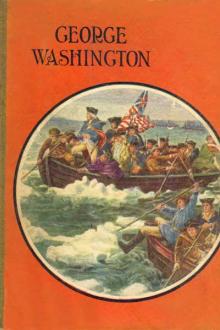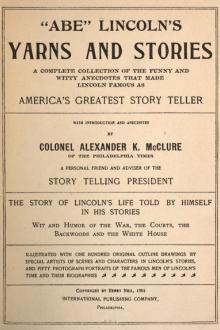The Civil War, James I. Robertson [good ebook reader TXT] 📗

- Author: James I. Robertson
- Performer: -
Book online «The Civil War, James I. Robertson [good ebook reader TXT] 📗». Author James I. Robertson
Now let us turn to the war itself and “follow the armies.”
SUGGESTED READINGS Beard, Charles A., The Rise of American Civilization, Volume II (1927). Channing, Edward, History of the United States, Volume VI (1925). Cole, Arthur C., The Irrepressible Conflict, 1850-1865 (1934). Craven, Avery O., The Coming of the Civil War (1942, 1957). ____, The Repressible Conflict (1939). Milton, George Fort, Conflict: The American Civil War (1941). Nevins, Allan, The Emergence of Lincoln (2 vols., 1950). Nichols, Roy F., The Disruption of American Democracy (1948). Pressly, Thomas J., Americans Interpret Their Civil War (1954). Randall, James G., and Donald, David, The Civil War and Reconstruction (1961). Rhodes, James Ford, Lectures on the American Civil War (1913). Rozwenc, Edwin C. (ed.) The Causes of the American Civil War (1961). Schlesinger, Arthur M., New Viewpoints in American History (1922). Stampp, Kenneth P., And the War Came (1950). ____, The Causes of the Civil War (1959).CHART OF CIVIL WAR ARMY ORGANIZATION
ARMY
General (CSA)
Major General (USA)
CORPS
Lieutenant General (CSA)
Major General (USA)
DIVISION
Major General
BRIGADE
Brigadier General
BATTALION (less than 10 companies)
Lieutenant Colonel or Major
COMPANY
Captain
REGIMENT (10 companies)
Colonel or Lieutenant Colonel
COMPANY
75-100 men
III. MILITARY CAMPAIGNS 1861Late in April, 1861, the Confederate government moved its capital from Montgomery, Ala., to Richmond, Va. This transfer was intended to bind Virginia closer to the other Southern states and to put the Confederate government nearer Washington when the time came to discuss the peace treaty. In reality the move backfired. It made Richmond the primary Federal target and Virginia the major battleground of the Civil War.
Few engagements occurred in 1861, when neither North nor South had a highly organized, efficient army. What both sides in 1861 called armies were more like armed and unruly mobs. Yet President Lincoln and the Congress, hoping to end the war quickly, were anxious to capture Richmond.
As a result, Federal forces made three thrusts into Virginia. They first moved from Ohio into the pro-Northern counties of western Virginia, where Confederate regiments as “green” as the Federal units were stationed. In a series of small battles, including Philippi (June 3), Rich Mountain (July 11), and Corrick’s Ford (July 13), the Federals were victorious. In 1863 this region entered the Union as the loyal state of West Virginia.
The other two Federal invasions were less successful. The main Virginia defenses stretched from Norfolk northward to the Potomac River, thence westward to Harpers Ferry. Early in June, Gen. Benjamin F. Butler left Fort Monroe with a Federal force and struck at Richmond by way of the peninsula between the James and York rivers. At Big Bethel Church, just west of Yorktown, Confederates attacked and sent Butler’s men stampeding back to their base at Fort Monroe.
Benjamin F. Butler, a politician with little military experience, led two ill-fated campaigns against Richmond.
The third and main Federal push into Virginia resulted in the largest battle fought in 1861. In mid-July, Gen. Irvin McDowell moved from Washington with some 35,000 recruits. McDowell’s ultimate target was Richmond, but first he had to capture the important railroad junction of Manassas. Through espionage agents the Confederates learned of McDowell’s advance. Quickly Gens. P. G. T. Beauregard and Joseph E. Johnston concentrated 30,000 Southern troops near Manassas to block the Federal move. On a very hot Sunday, July 21, McDowell attacked Beauregard and Johnston near a stream known as Bull Run. As in the case of many Civil War battles, the main attack was against the flank (or end) of the line, while for deception a lesser assault force struck at the center of the defending force’s position.
A great-nephew of Patrick Henry, “Uncle Joe” Johnston proved a superb army commander. Yet he and President Davis had too many personal and official differences during the war.
The Federals might have won a smashing victory that day but for a stubborn brigade of Virginians under Gen. Thomas J. Jackson. The refusal of Jackson and his men to give ground not only helped save the day for the South but also earned for that general and his brigade the name “Stonewall.”
Losses in the battle of First Manassas, or First Bull Run, were much less than those in the larger battles to come. The Federals lost 2,896 men killed, wounded, and missing. The Confederates suffered 1,982 casualties.
This battle at Manassas had several important effects. Southerners were convinced that Yankees were poor fighters, and that the war would be brief. On the other hand, Northerners realized that defeating the Confederacy would take longer than anticipated. Thus, while Southerners celebrated a great victory, the North began raising and equipping large armies for full-scale war.
A month later occurred an engagement in the West. On August 10, a Federal army sought out and attacked a Confederate force at Wilson’s Creek, near Springfield, Mo. In this battle, often called “Bull Run of the West,” the Federals met defeat. The Union commander, Gen. Nathaniel Lyon, was killed in the midst of the fighting.
On October 21, the North suffered another costly setback. Near Ball’s Bluff, Va., Confederate defenders all but annihilated a Federal scouting force. The “Ball’s Bluff disaster” spurred into action the “Committee on the Conduct of the War.” Seven U. S. congressmen made up this investigating body. Although not one had had army training, they continually inquired into the military affairs of every Federal army and often embarrassed generals in the field.
While Confederates in 1861 won most of the battles, Lincoln and his government by no means felt defeated. Gen. George B. McClellan was building an army at Washington that would soon number 100,000 volunteer troops. This force would be the largest ever amassed in the Western Hemisphere up to that time. Moreover, the North had won a few victories. On November 7, a Federal amphibious force had captured Port Royal, S. C., thus gaining a beachhead on the South Atlantic coast. Yet on that same day, another Federal army suffered defeat at Belmont, Mo. The losing general was an unknown officer from Illinois, and this was his first Civil War battle. His name was Ulysses S. Grant.
1862 IN THE WESTWar’s full fury struck in 1862. To understand the complicated movements of many armies, bear in mind two points:
(1) Not one, but two, separate areas of military operations existed. The Appalachian Mountains, extending in an almost unbroken line from Pennsylvania to Alabama, prevented armies from moving freely from eastern states (Virginia, the Carolinas, etc.) to western or trans-Appalachian states (Tennessee, Kentucky, etc.), and vice versa. As a result, different armies in the East (east of the mountains) and in the West fought practically two almost independent wars. Only in 1864 were the campaigns of the two areas effectively coordinated.
(2) In the 1800’s, in contrast to modern military tactics, an invading army did not always move directly against an enemy force. Rather, its primary target was usually an important city. Once the invading army was in motion, the defending force then tried to place itself between the invader and his target. This set the stage for battle. Five such Confederate cities became principal Federal targets. In the East was Richmond; in the West were New Orleans and Vicksburg, both strongholds on the all-important Mississippi River, and Chattanooga and Atlanta, vital railroad centers.
Bearing these two points in mind, let us turn to the Western campaigns of 1862.
At the beginning of 1862 some 48,000 Confederate soldiers guarded a 600-mile line extending from the Appalachian Mountains westward to the Mississippi River. Obviously the Southern defenses were thinly manned. Early in February, Gen. Ulysses S. Grant left Cairo, Ill., with 15,000 men to attack the center of this line. His goal was to gain control of two important rivers, the Tennessee and the Cumberland.
To protect these streams, the Confederates had constructed twin forts in Tennessee just south of the Kentucky border. Fort Henry guarded the Tennessee; Fort Donelson stood menacingly on the banks of the Cumberland. On February 6 a Federal river fleet cooperating with Grant battered Fort Henry into submission. Ten days later Grant had surrounded Fort Donelson and its 12,000 defenders. Answering the Confederate commander’s request for surrender terms, Grant replied: “No terms but unconditional surrender.” Thereafter, U. S. Grant was “Unconditional Surrender” Grant.
Grant’s victories brought great rejoicing in the North. Some writers consider the Henry-Donelson campaign as “the critical operation” of the Civil War. Capture of these forts assured Union control of Kentucky and Tennessee and opened Mississippi and Alabama to Federal invasion. The loss of the forts was a severe blow to Southern morale. With these successes the North had also demonstrated its ability and willingness to fight.
Meanwhile, an important battle occurred farther to the west for control of Arkansas and Missouri. On March 7-8, at Pea Ridge (or Elkhorn Tavern), Ark., a Confederate army of 16,000 men attacked 12,000 Federals under Gen. Samuel R. Curtis. Most of the Confederates lacked uniforms and were armed with shotguns and squirrel rifles. This force also included 3,500 Indians of the Creek, Choctaw, Cherokee, Chickasaw and Seminole tribes. After two days of fighting, a Federal counterattack broke the Confederate “army.” With the defeat at Pea Ridge the Confederates permanently lost Missouri and northern Arkansas.
Gunfire and fighting at Shiloh was so intense that one area of the battlefield became known as the “Hornet’s Nest.” This drawing depicts the stubborn resistance of two Federal divisions in that area.
By the end of March Grant’s army was near the Mississippi border. Just across the line Gens. Albert Sidney Johnston and Beauregard had collected a force of 40,000 Confederates. Even though most of his troops were ill-equipped, Johnston attacked Grant’s encamped forces in an effort to destroy the Federal invaders. The battle of Shiloh (April 6-7), one of the war’s most costly engagements, followed.
The initial Confederate attack caught Grant by surprise, bent his line, but never broke it. Several events then swung the battle to the North’s favor. Gen. Johnston bled to death from a leg wound. Exhaustion and disorganization blunted the drive of the Southerners, and Federal artillery posted in great strength near the Tennessee River proved an effective barrier to the Confederate advance. Heavy Federal reinforcements under Gen. Don C. Buell arrived during the night. The next morning Grant counterattacked. The Confederates retreated grudgingly to Corinth, thus ending the battle. Grant’s hard-won victory cost him 13,047 casualties. The Confederates lost 10,694 soldiers, roughly one-fourth of Johnston’s forces.
For the next four months the armies of Grant and Bragg (who eventually succeeded to command) did not meet in battle. However, three significant events took place elsewhere in the Western theater.
One was the Federal capture of the mouth of the Mississippi River. In April a fleet under Flag Officer David G. Farragut blasted its way upriver past Forts Jackson and St. Philip. By the end of May the strategic river cities of New Orleans, Baton Rouge and Natchez were under Federal control. Yet a river attack on Vicksburg failed.
The second event was one of the boldest raids in American history. In April James J. Andrews, a Federal espionage agent, and twenty-one Northern soldiers sneaked through Confederate territory to Big Shanty Station, Ga., only thirty miles from Atlanta. There they stole the engine “General” and two cars of a Western & Atlantic passenger train. The Federals’ plan was to race up the tracks to Chattanooga, removing rails, burning bridges,





Comments (0)